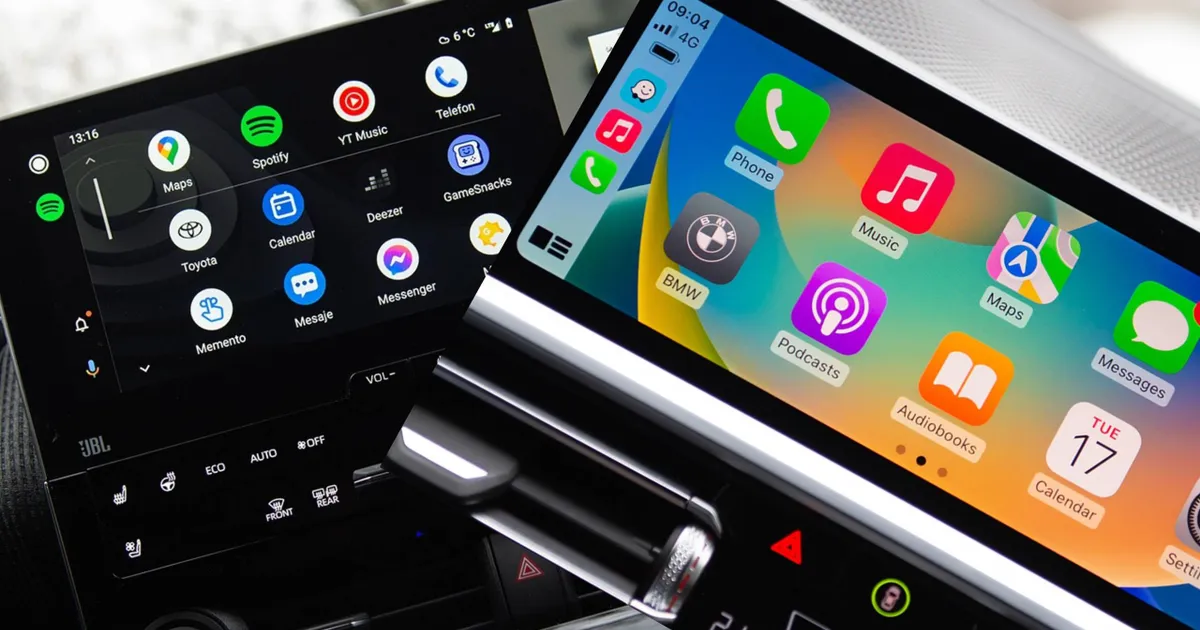
Car infotainment systems used to be slow and clunky. Apple CarPlay and Android Auto changed that. They turned your car’s screen into a smart, phone-like interface. For many drivers, plugging in a phone is now as normal as buckling a seat belt.
CarPlay follows Apple’s philosophy. It is simple and clean. It “just works” and feels like using an iPhone. Android Auto follows Google’s approach. It offers more control, more features, and a lot of freedom. Both systems are great, but Android Auto now has some strong advantages. Here are eight reasons why Android Auto is ahead of CarPlay today.
1. Gemini AI Outshines Siri in Context and Helpfulness
Voice assistants used to act like remote controls. You said a command, and they obeyed. Google changed that by adding Gemini to Android Auto. Gemini doesn’t just react; it thinks about context.
Imagine you’re driving, and your group chat explodes with messages. Siri in CarPlay will read every single one, which can be distracting. Gemini waits until the chat slows down. Then it gives you a quick, clear summary.
Gemini can also remember details between questions. You can ask, “Find coffee shops along my route,” and then follow up with, “How late is the second one open?” without repeating anything. Siri often needs you to start over.
Because Gemini connects to your Google services, it can even pull info from Gmail—like the address of your kid’s soccer game. With this kind of deeper integration in place, driving becomes less stressful.
2. Android Auto Users Get More Apps and Services
As we all know, Google’s ecosystem is an open ecosystem, and this extends the Android Auto system. Due to this, Android auto has the ability to work with more third-party apps than CarPlay. This opens the door for users to access their favorite media players, navigation apps and more.
Apple’s tightly controlled CarPlay ensures quality and safety. But this users who like to explore more apps. With Android auto, you are given the freedom to use any app of your choice.
3. Smart Home Control from the Driver’s Seat
Android Auto connects with Google Home. That means you can control smart devices while on the road. You can lower your thermostat, turn lights on or off, check if the garage door is closed, or run routines with one voice command.
Google’s Routines feature can combine actions. For example, as you approach home, Gemini can turn on your porch lights and open the garage door with a single phrase. CarPlay offers Shortcuts, but they don’t always run smoothly, and Siri may block certain commands while you drive for safety reasons.
Flexible Split-Screen and Widgets
Android Auto makes multitasking easier. Its split-screen mode lets you run two apps at once. You can keep Google Maps on one side and Spotify or YouTube Music on the other. You can also add glanceable widgets for weather, messages, or your calendar.
CarPlay has a dashboard view, but it’s more rigid. Even with improvements in iOS 26, Android Auto’s layout still feels more adaptable. You can scroll vertically, rearrange items, and apply Material You theming to match your phone’s wallpaper. This level of personalization is something Apple only recently started offering.
5. Power Features for Enthusiasts
Android Auto offers a Developer Mode. Don’t let the name scare you—it’s not just for coders. It unlocks useful tweaks for everyday users.
For example, you can force Day or Night mode if your car’s light sensor doesn’t work properly. You can adjust video resolution on aftermarket head units to fix display problems. The Unknown Sources toggle even lets you sideload some apps, like YouTube or web browsers, with certain limitations.
CarPlay doesn’t give you this kind of freedom. Users only have the option of living with what Apple provides, leaving them with little or no room for further customization.
6. Entertainment Options While Parked
Android Auto is adding video streaming, web browsing, and simple games when your car is parked. This is great for moments when you’re waiting—like charging an electric vehicle or picking someone up.
Google has shown demos of these features, which are expected to roll out with Android 16 on select cars. CarPlay doesn’t yet match this. It allows AirPlay mirroring, so you can display video from your iPhone on the car’s screen, but that’s not the same as native streaming or browsing within CarPlay.
7. Android Auto Users Get More Frequent Updates than CarPlay Users
It is an undenying fact that Android auto gets more frequent releases than CarPlay. Because it’s tied to Google Play Services, it can get new features, interface tweaks, and bug fixes several times a year. You don’t have to wait for a major Android release to see changes.
CarPlay updates usually arrive once a year with new versions of iOS. Even though this ensures stability in the long run, it usually langs behind in new ideas and features.
8. More Control Over Appearance and Layout
Google gives Android Auto users plenty of ways to make the interface their own. You can reorganize the home screen, pick favorite apps, and adjust widgets. Having Material You theming makes Android Auto more personal. The system picks its wallpaper and colors from that of the connected phone.
Future Expectations
Apple may be late in introducing certan features but the company always has its own way of catching up. The company is currently working on Apple Intelligence which could potentially bring smart AI features to CarPlay in the near future. The gap between Android Auto and CarPlay could dwindle if the company is able to bring AI to CarPlay.
For now, though, Android Auto offers a richer, more adaptable experience. Whether it’s smarter voice commands, better multitasking, or controlling your home from the road, Android Auto proves why openness and speed matter in tech.



